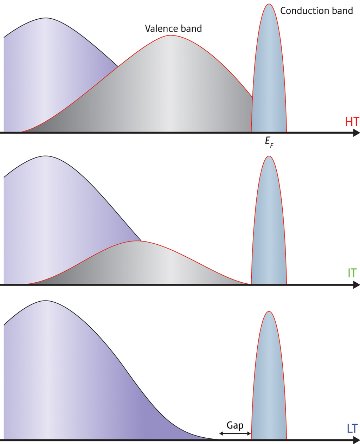May 28, 2010 Research Highlight Physics / Astronomy
Semiconducting sandwich filling retains its mystery
Solving part of the long-standing puzzle of the electronic properties of an enigmatic temperature phase of a titanium oxide may yield new clues
 Figure 1: The electronic phases of Ti4O7. In the high-temperature (HT) range (top), coherent electrons from the valence band (gray) reach the conduction band so it is metallic. In the intermediate-temperature (IT) range (middle), only a few coherent electrons remain, which are a remnant of the metallic state. In the low-temperature (LT) range (bottom), the gap in the electronic phases means it is an insulator. Reproduced, with permission, from Ref. 1 © 2010 the American Physical Society
Figure 1: The electronic phases of Ti4O7. In the high-temperature (HT) range (top), coherent electrons from the valence band (gray) reach the conduction band so it is metallic. In the intermediate-temperature (IT) range (middle), only a few coherent electrons remain, which are a remnant of the metallic state. In the low-temperature (LT) range (bottom), the gap in the electronic phases means it is an insulator. Reproduced, with permission, from Ref. 1 © 2010 the American Physical Society
Oxides of transition metals such as titanium are of interest for applications, such as hydrogen gas sensors or as catalysts, and have intriguing fundamental physical properties. In particular, the origin of an intermediate temperature phase of the compound Ti4O7 has puzzled scientists for decades. By studying the different electrical phases of Ti4O7, researchers from the RIKEN SPring-8 Center in Harima, along with colleagues from other institutions in Japan, have now taken important steps towards understanding the fundamental differences between the compound’s electrical conductivity at room and low temperatures, and the enigmatic phase that forms at intermediate temperatures1.
At room temperature and down to temperatures of 154 K, Ti4O7 is an excellent conductor, as it allows fast transport of electrical charges. At temperatures below 142 K, the compound is an electrical insulator. Between 142 K and 154 K, however, the mysterious intermediate temperature phase sets in where the compound is semiconducting. Both, the metallic and the insulating phases are well understood by classical theories. The semiconducting phase, however, is very strange and complex; its origin is particularly interesting because it is sandwiched by two such well-known phases, explains Munetaka Taguchi from the research team.
To elucidate the origin of the semiconducting phase, the researchers studied the electronic phases at the top of the valence band and bottom of the conduction band that are responsible for the electrical conduction. They employed the techniques of electron photoemission and x-ray absorption, which combined provide a detailed picture of the electronic phases.
In the high-temperature phase, Taguchi and colleagues found that so-called ‘coherent valence electrons’ extended as far as the conduction band, making it a metallic conductor. In the insulating phase, there is a gap in the electronic band structure and no electrons are available in the conduction band. For the intermediate regime, however, a small number of coherent electronic phases remain close to the conduction band and explain the measured electrical conductivity (Fig. 1).
While it is clear that the small number of coherent electrons is a remnant of the metallic phase, the transformation path—from the semiconducting state to both the room-temperature metal and the low-temperature insulating phase—remains unclear, notes Taguchi. With such crucial fundamental questions still unsolved, more work is needed to study the nature of the coherent electronic phases, which Taguchi hopes “will provide us [with] vital clues to a more complete understanding of phase transitions.”
References
- 1. Taguchi, M., Chainan, A., Matsunami, M., Eguchi, R., Takata, Y., Yabashi, M., Tamasaku, K., Nihino, Y., Ishikawa, T., Tsuda, S. et al. Anomalous state sandwiched between fermi liquid and charge ordered Mott-insulating phases of Ti4O7. Physical Review Letters 104, 106401 (2010). doi: 10.1103/PhysRevLett.104.106401
